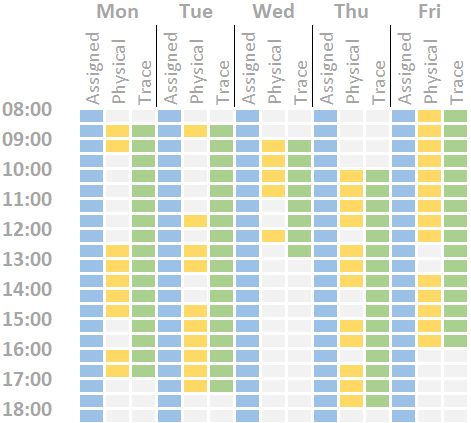As illustrated below, this example considers a workstation over a one-weekperiod (Monday to Friday). For simplicity, it is assumed that all Occupancy episodes occur in precise 30-minute periods. In practice, of course, this willnot be the case, but it is a helpful simplification when discussing an example. For each 30-minute period, starting at 08:00 and finishing at 18:30, the assigned, physical, and trace occupancy is shown. The business hours of this location are in 09:00 to 17:00, and core hours are considered 10:00 –12:00 and 14:00 – 16:00.

The following observations can be made from this data:
- The workstation is permanently assigned and therefore the Assigned Utilization is 100%;
- The Physical Utilization during the recorded hours is 47.6%, because there are 50 physically occupied 30-minute periods out of a total of 5 x 21 = 105 periods;
- The Physical Utilization during business hours is 57.5%, because there are 46 physically occupied 30-minute periods between 09:00 and 17:00 out of a total of 5 x 16 = 80 periods;
- The Physical Utilization during core hours is 55%, because there are 22 physically occupied 30-minute periods between 10:00 and 12:00 or 14:00 and 16:00 out of a total of 5 x 8 = 40 periods;
- The Trace Utilization during the recorded hours is 71.4%, because there are 75 x 30-minute periods showing trace occupancy out of a total of 5 x 21 = 105 periods;
- The Trace Utilization during business hours is 85%, because there are 68 x 30-minute periods showing trace occupancy between 09:00 and 17:00 out of a total of 5 x 16 = 80 periods;
- The Trace Utilization during core hours is 90%, because there are 36 x 30-minute periods showing trace occupancy between 10:00 and 12:00 or 14:00 and 16:00 out of a total of 5 x 8 = 40 periods;
In this example, some of the inference that might be considered from the data include:
- The Space show no trace of occupancy on Wednesday afternoon. It might be that the occupant left the office at lunchtime, or that they cleared their desk and went to another work setting within the office for the afternoon (perhaps a workshop, or somewhere more suitable for their Activity during that period);
- On Thursday there is no physical or trace occupancy until 10:00. This may be because the occupant did not arrive in to the office until that time, but it could also be because they went straight to another work setting when they first arrived (perhaps a meeting) and didn’t come to their desk until that activity was complete;
- There are several examples throughout the week of trace occupancy without physical occupancy – these represent periods when the occupant is away from the workstation but has left traces of occupancy at the workstation (perhaps by leaving their laptop there, or jacket on the back of the chair);
- Physical Utilization is higher during business hours than core hours, whilst Trace Utilization is higher during core hours than business hours. This often happens in certain role types because core hours are often when meetings are scheduled, as it is when more people are in the office. This means people are often away from their desks but have left physical signs of occupancy.